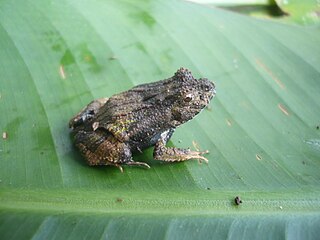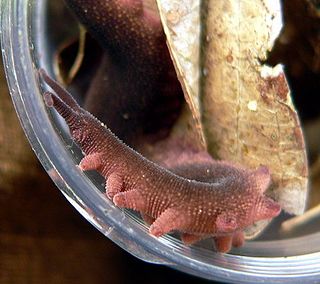
Edalorhina perezi is a species of frog in the family Leptodactylidae. It is one of the only two species in the genus Edalorhina in the family Leptodactylidae. This species is diurnal and terrestrial. During mating season both female and male frogs gather around treefall pools. It is found in Brazil, Colombia, Ecuador, and Peru, and possibly Bolivia. Its natural habitats are subtropical or tropical moist lowland forests, subtropical or tropical moist montane forests, and freshwater marshes. The species listed as least concern on the IUCN Red List and the population is stable.
Ptychadena pujoli is a species of frog in the family Ptychadenidae. It is known from Macenta and Sérédou in Guinea, Sukurela in Sierra Leone, and Mount Nimba in Liberia and Ivory Coast. Description of Ptychadena pujoli is based on old museum specimens, and very little is known about the ecology of this relatively recently (1997) described species.

Archaeoniscus is a genus of prehistoric isopods that first appeared during the Bajocian stage of the Middle Jurassic. It is a widespread genus with a paleogeographic distribution encompassing the continental margin environments of the central Atlantic Ocean and the western Tethys Ocean. Fossils of Archaeoniscus suggest that this genus lived in diverse aquatic habitats, including the marine, paralic, and freshwater environments. While earlier descriptions suggested that it may have had an ectoparasitic association with fishes, some researchers argue that at least two species, A. aranguthyorum and A. coreaensis, lived a benthic free-living lifestyle based on morphological characteristics that are either unsuitable for or unrelated to parasitic behavior.
Sphaeroma terebrans is a mangrove-boring isopod, first described by Spence Bate in 1866. It is 8–10 millimetres (0.31–0.39 in) long, and is thought to have been introduced to North America by wooden-hulled ships. The isopod is found throughout the Gulf of Mexico mainly in mangrove swamps of Louisiana and Florida. S. terebrans will also bore into boats, wooden pilings and other wooden structures.

Eoperipatus totoro is a species of velvet worm of the family Peripatidae. This species is notable as the first velvet worm from Vietnam to be formally described. As of 2024, E. totoro remains the only species of velvet worm from Vietnam to be described.

Emplastus is an extinct morphogenus of ants in the subfamily Dolichoderinae, known from fossils found in Asia and Europe. The genus contains twelve species described from sites in England, Eastern Europe and Far Eastern Russia.

Exosphaeroma is a genus of marine isopod of the family Sphaeromatidae. This genus is found in shallow ocean waters worldwide. It is notable for being one of the few genera of sphaeromatid to be found in the southern reaches of the Southern Ocean. The greatest diversity of Exosphaeroma occurs in the Southern Hemisphere.
Exosphaeroma pentcheffi is a species of marine isopod of the family Sphaeromatidae.
Eoperipatus horsti is a species of velvet worm in the Peripatidae family. Authorities have designated this velvet worm as the type species for the genus Eoperipatus, because among the species originally included in this genus, this species is the only one known from descriptions of both sexes. This species is found in Malaysia.
Epiperipatus cratensis is a species of velvet worm in the family Peripatidae. This species is found in northeastern Brazil. This velvet worm is notable as a small species of Epiperipatus with many legs.
Epiperipatus hilkae is a species of velvet worm in the Peripatidae family. This species is found in Costa Rica. This velvet worm is closely related to another species of Epiperipatus found in Costa Rica, E. isthmicola. The species E. hilkae is named in honor of the German zoologist Hilke Ruhberg for her extensive work on velvet worms.
Oroperipatus lankesteri is a species of velvet worm in the Peripatidae family. This velvet worm is notable for its large size, reaching 82 mm in length. This species is known only from its type locality in the northern Pacific lowlands of Ecuador.
Peripatus dominicae is a species of velvet worm in the Peripatidae family. The type locality for this species is on the Caribbean island of Dominica. Although the Canadian zoologist Stewart Peck introduced the name Peripatus dominicae dominicae in 1975 to distinguish the original species from other subspecies then assigned to P. dominicae, authorities now deem these subspecies to be separate species in light of the significant distances between their type localities.
Peripatopsis sedgwicki is a species of velvet worm in the Peripatopsidae family. Also known as the Tsitsikamma velvet worm, this species has a narrow geographic distribution in South Africa but is especially abundant in the indigenous forest of the Tsitsikamma mountains. Recent phylogenetic analysis using molecular data finds that Peripatopsis sedgwicki as traditionally understood based on morphology is a species complex that contains four different species: P. sedgwicki s.s., P. orientalis, P. collarium, and P. margaritarius.

Exosphaeroma laeviusculum is a species of isopod in the family Sphaeromatidae, native to the west coast of southern Africa.
Scutuloidea kutu is a species of marine isopods in the family Sphaeromatidae, first described by Stephenson and Riley in 1996. No subspecies are listed in the Catalog of Life. The name "kutu" was chosen as a metaphor, as the species lives on seaweed.
Epiperipatus hyperbolicus is a species of velvet worm in the family Peripatidae. This velvet worm is known only from its type locality in the state of Alagoas in Brazil. The species name refers to the unusually large apical piece on the primary papillae on this velvet worm. This distinctive apical piece is notable for its size and spherical shape. The males of this species have 23 pairs of legs; females have 24 or 25 pairs.
Epiperipatus titanicus is a species of velvet worm in the family Peripatidae. This velvet worm is known only from its type locality in the state of Alagoas in Brazil. The species name refers to the large size of its females and its numerous legs. This species features more legs than any other Brazilian species of velvet worm.

Tisamenus cervicornis is a stick insect species (Phasmatodea), in the family of the Heteropterygidae endemic to the Philippine island Luzon.
Prosopodesmus panporus is a species of flat-backed millipede in the family Haplodesmidae. Also known as the hothouse millipede, this species was first discovered in hothouses for tropical plants in England, where it is well established, but is probably native to Australia. This species features a unique distribution of ozopores, which appear on all segments with two pairs of legs. The species P. panporus is named for this complete series of ozopores and is the only species in the order Polydesmida with this distribution. This millipede is also notable for exhibiting sexual dimorphism in segment number: Whereas adult females of this species feature the 20 segments usually observed in the order Polydesmida, the adult males of this species feature only 19 segments.






